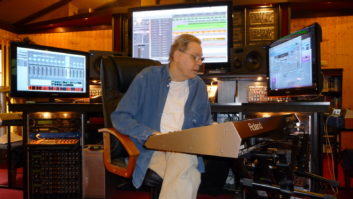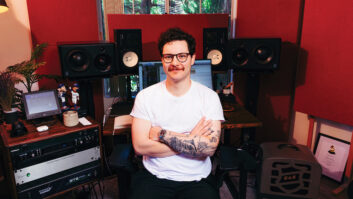Esplanade Studios opened this earlier year, staking claim as the largest studio in Louisiana at 14,000 square feet. The facility, a former church built in the 1920s, is a gem of a recording studio that rose from ashes of Hurricane Katrina.
Owner Misha Kachkachishvili set his own roots down in New Orleans almost 20 years ago. Originally here as a musician through an exchange program between the Georgian Conservatory of the Republic of Georgia and Loyola University New Orleans, he fell in love with The Big Easy because of its vibrant people, its food and culture, and of course, its music. After starting a small studio in the bedroom of his house and playing throughout the area as a session musician, he soon pursued a commercial studio venture more seriously by opening Axis Studio, which operated for nearly a decade in a nearby suburb. As more and more of his work became centered on orchestral and scoring projects, a larger space was required that was more accommodating to his growing clientele.
Kachkachishvili became aligned with a business partner and co-investor who shared his vision—which was partly inspired by the generous tax incentives Louisiana offers for recording audio and film—and began seeking a new space.
“I looked at old firehouses, churches and other structures, and wanted enough space to accommodate a full scoring stage since I was already working with classical players and doing that kind of work,” he recalls. A building came on the market that was flooded and destroyed by Hurricane Katrina. But when Kachkachishvili saw the building, he didn’t see a dilapidated structure— instead, he saw a longtime dream, realized.
“When I walked inside the sanctuary— what would become the live room—it was just spectacular,” he recalls. “It had 30 foot high ceilings and by itself, was around 3,400 or 3,500 square feet. I immediately knew this was the place I needed to get to build a larger recording space with cool acoustics and a scoring stage.”
Acquiring a ‘fixer upper’ can be a scary business, though Kachkachishvili, who has owned and renovated homes in the past, says that he was able to get the building at a good price. “The damage to the building was catastrophic, so I was terrified to acquire it,” he says. “The building has these gigantic windows that are about 20 feet high and 10 feet wide. These were completely blown by the wind,” he says. “In addition, the roof was partially gone and the floors were collapsed and eaten by termites.” Despite all this, the foundation was intact, constructed of multi-layers of brick and concrete construction.
The studio layout was fairly straightforward, with the primary existing spaces being a sanctuary and choir loft. “Upstairs just became the control room; the sanctuary, the live room; and all the adjacent rooms below, previously used for teaching studies, became the iso rooms,” says Kachkachishvili. “So there was not much to design except making everything soundproof, placing the acoustics around it, and running the cables.”
At the end of the day, the project exceeded his budget, but due to persistence and an unrelenting vision, the project was completed a year and eight months later.
In addition to the required repairs to the building itself, he took great care to bring the historic structure back to its original beauty. His construction crew rebuilt the windows to original specifications, including bending the wood at the tops and sourcing old-looking glass from Europe. “It became a historic preservation project and I worked within the requirements of National Park Services so we could all be proud of it,” he states.
Kachkachishvili built the control room, which also included an iso booth, using ‘room within a room’ construction techniques, ensuring proper isolation from the rest of the facility. He then entirely covered the walls with custom, fabric-covered acoustic panels. Inside the live room, where he didn’t require isolation but instead had to reduce an unacceptably long six-second reverb time, he tore down the existing walls and rebuilt them with acoustically absorbent insulation. He then mounted 4’ x 8’ custom acoustic panels to help manage room reflections, while hanging large curtains in front of the windows. He says when the curtains are open, the natural light within the facility is fabulous. “You can’t see through the glass, but it passes the daylight. Most of the time, I don’t even use light except on orchestral scoring sessions,” says Kachkachishvili.
Once the infrastructure of the studio was complete, he moved his Trident TSM 48 channel split console, originally acquired in 2003, into the control room. “This console has 48 channels in the main frame and 32 channels on playback,” he says. “For my orchestral sessions, I will use a Decca tree with my outboard preamps, but I use the Trident for the rest of the inputs,” he says. He uses an Avid Pro Tools HD3 system to capture digital audio, but also maintains a vintage MCI JH-24 2-inch machine that he typically uses for recording rock and jazz projects that call for an analog vibe. For monitors, he has come to rely on a pair of freestanding Dunlavy midfield monitors, which he has used since 2002 and is extremely happy with. “They are not as vibrant or dynamic as other speakers, but they are very accurate,” he says. “My control room is 1,700 square feet, so the space between the console and the workspace feels very large. This helps me locate the perfect sweet spot for the speakers.”
Despite the devastating effects of Hurricane Katrina and the months of hard labor that went into creating Esplanade, Kachkachishvili is ecstatic about the results. “The space sounds phenomenal,” he concludes. “The acoustics are great and the reverb time is now just above 2.2 seconds.” Esplanade has already been used to record the scores for two upcoming films, Black and White, directed by Mike Binder, and A Medea Christmas, directed by Tyler Perry, among other projects.
Esplanade Studios
esplanadestudios.com







